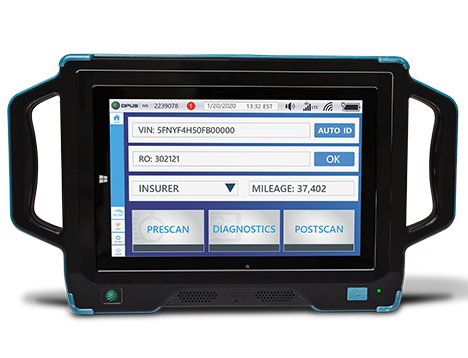Right To Repair Efforts Continue to Make Strides
Massachusetts decision a landmark ruling for the automotive aftermarket...

By Brian Herron
Editor’s note: This article was supplied by Opus IVS.
A major legal development has reshaped automotive repair rights in Massachusetts, promising broader access for independent repair shops, diagnostic providers and vehicle owners.
A federal judge recently dismissed the automakers’ lawsuit against the 2020 Massachusetts Data Access Law, allowing the Right to Repair legislation to stand. This decision has significant implications not just for the state’s automotive aftermarket but for the entire repair industry nationwide and beyond.
One might ask: Why do we need Right to Repair? Several automakers already work closely with independent repairers, offering tools and data on a level that’s equal or almost equal to dealerships. In some cases, they even exceed basic requirements, suggesting that formal legislation might not always be necessary. I’ve personally witnessed how certain automakers value collaboration with the repair sector.
However, Right to Repair fulfills two key functions:
-
- First, it creates a clear framework for those automakers that may not otherwise voluntarily comply, ensuring an even playing field. Industry examples show that, without such a standard, some manufacturers might restrict or overprice tool and data access.
- Second, for those already supporting independent repair, having regulations in place provides internal justification to allocate resources and make repair-access initiatives a priority.
Dealerships play a crucial role in vehicle repair. They invest heavily in brand-specific training, infrastructure and franchise fees to support manufacturer repair programs. Right to Repair is not about diminishing the value of dealerships but about creating fair competition and ensuring access to necessary repair information. In fact, many dealerships benefit from Right to Repair as well, since they often service multiple brands beyond the ones they represent.
By ensuring fair access to OEM diagnostics across multiple manufacturers, dealerships that repair off-brand vehicles gain the same advantages as independent repairers, fostering a more level playing field.
At the heart of the recent Massachusetts ruling is fair access to vehicle data. The law requires that independent repairers receive the same diagnostic and repair capabilities as dealerships. This ruling addresses concerns around the rise of secure gateways and telematics-based diagnostics, which could have limited or delayed aftermarket access if not properly regulated.
Key Provisions Driving Change
Under the 2020 Massachusetts law, two core elements reshape the way repairs and diagnostics are handled:
-
- Secure Gateway Access – Automakers deploying secure gateways must ensure aftermarket repairers can access essential repair data in a standardized, unbiased manner.
- Telematics Access – As some manufacturers shift from traditional OBD ports to cloud-based diagnostics, independent shops now have a pathway to telematics information, keeping them competitive in servicing modern vehicles.
These measures reinforce that vehicle owners and independent service providers should not be locked into dealership-only repair models.
I recall being in Massachusetts more than six years ago, helping industry colleagues draft language for secure gateway access. We were solving an urgent issue when Stellantis (then FCA) first introduced its Secure Gateway Module (SGW), which initially limited key diagnostic functionality outside the OEM network.
The Rise of Secure Gateways
Secure gateways protect vehicles against cyber threats by regulating access to electronic control units (ECUs). However, this can also impact independent repairers if basic diagnostic procedures—like clearing fault codes or running bi-directional component tests—are restricted without OEM approval.
FCA’s (now Stellantis) SGW in 2018 caused non-OEM scan tools to lose code clearing and bidirectional capabilities, leading to immediate aftermarket concerns. FCA later created a registered-user system, but it entailed additional steps, such as account verifications, fees and licensing requirements.
Other automakers followed suit, each with unique policies. Some also require proof of technician training, which can be challenging for small or remote repair businesses.
Recently, the National Automotive Service Task Force (NASTF) announced that Hyundai and Kia secure gateway access will soon be available—potentially in a standardized way. This could be a positive step forward, so long as NASTF allows any registered aftermarket diagnostic tool to access the secure gateway, much like the FCA solution that was eventually deployed.
However, if NASTF implements the same stringent process it uses for key replacement—requiring user identification, professional credentials and additional OEM-imposed requirements—it could create barriers instead of solutions. This is an important development to watch closely.
The 2020 Massachusetts Right to Repair law ensures that secure gateways are standardized and not arbitrarily restricted by manufacturer policies. It also opens the door for third-party organizations, such as Equipment and Tool Institute (ETI), NASTF and others, to work with automakers to ensure secure gateway access complies with the open access requirements outlined in the 2020 legislation.
Telematics Access: A Hard-Fought Battle
Telematics access was one of the most contested issues in this law. In trying to avert additional requirements, the Auto Alliance proposed an alternative Memorandum of Understanding (MOU) and promoted a federal proposal called SAFE (Safety as a First Emphasis).
However, the alternative MOU and SAFE proposal does not come without compromises. Not only is the requirement missing that independent repairers receive telematics data on equal and identical footing with dealerships, but it also misses elements protecting against secure gateway restrictions or preventing manufacturers from locking out users based on training, experience or other arbitrary OEM-imposed requirements. This means automakers could still dictate who could service vehicles, undermining the very principles of Right to Repair.
For Example, the alternative MOU would only require aftermarket telematics access if no physical OBD port could offer “the same data” as telematics. Since Right to Repair focuses on giving dealers and the aftermarket truly equal access, the SAFE approach has been seen by some as a step backward.
Competing Approaches
To address telematics, two main models emerged:
-
- Secure Vehicle Interface (SVI): Supported by Autocare and the Right to Repair Coalition, SVI calls for direct in-vehicle access, offering real-time, comprehensive diagnostics.
- Extended Vehicle (ExVE): Preferred by some automakers, ExVE relies on a cloud-based “digital twin” of the vehicle, with the manufacturer controlling the flow of data to independent repairers.
The Massachusetts 2020 law specifically supports SVI, promoting direct access rather than an OEM-managed cloud model. However, achieving SVI for all automakers is a significant undertaking and will likely take years to finalize.
A Path Toward National & Federal Reform
The Massachusetts decision builds on the original 2012 law that led to a national MOU in 2014, but it also acknowledges that rapid technological changes weren’t fully anticipated back then. This ruling might inspire other states or even federal lawmakers to consider nationwide Right to Repair legislation—such as the Right to Equitable and Professional Auto Industry Repair (REPAIR) Act.
The REPAIR Act and SAFE Act are exciting legislative developments, but it is critical that any national law moves the industry forward without compromising the protections already established in the 2014 MOU or the 2020 Massachusetts law regarding secure gateways.
Many stakeholders—automakers, repairers and consumers—were deeply involved in crafting those regulations, which are vital to preserving competition and ensuring independent access to essential repair data. Any new legislation should enhance these rights, not erode them.
Collaboration Over Litigation
While automakers can still appeal the ruling, many industry observers see this as a chance for cooperation instead of ongoing legal battles. OEMs, aftermarket groups and other stakeholders could work toward a modernized MOU that addresses cybersecurity, telematics and fair pricing.
Tools like SAE J2534—an industry standard for vehicle and tool communication—exemplify how standards can streamline and democratize data access.
For any MOU to be successful and both sides of the debate to reach harmony, a 2025 MOU should bring the key parties from the 2014 MOU together to resolve the open issues, make compromises and deliver on the concept of Right to Repair—that the independent aftermarket and those companies that develop tools for the market have access to the same capabilities as the dealerships, at a fair and reasonable price.
Additional Challenges Lie Ahead
Enforcement remains a concern, as do the costs of OEM licensing for diagnostic data. Emerging technologies like Service-Oriented Vehicle Diagnostics (SOVD) introduce new complexities, raising questions about how to ensure equitable access to crucial repair information.
Additionally, future regulations—like NHTSA’s 2029 ADAS (Advanced Driver-Assistance Systems) mandates —will require that advanced safety systems remain fully functional post-repair or modification.
The aftermarket community must keep working with OEMs, regulators and tool providers to manage these evolving technologies. Together, they can ensure innovation, safety and open access for all.
The Modification/Customization Impact
Specifically for the specialty automotive aftermarket, as vehicles grow more technologically sophisticated, modifications and customizations must advance in tandem to maintain critical safety features such as ADAS.
Aftermarket upgrades—like lift kits or wheels and tires—may alter ADAS functions, emphasizing the need for proper recalibration. Developing a standardized ADAS Readiness Test could help shops verify that safety systems remain fully operational after any customization.

For that matter, the industry needs such a test for repairers and regulators as well to ensure compliance with NHTSA ADAS mandates during vehicle manufacturing, sale, maintenance, collision repair and periodic safety inspections.
Collaborations between automakers, regulators and the aftermarket industry are vital for balancing personalization, technological advancement and road safety.
Call to Action
For nearly two decades, I have been deeply involved in Right to Repair, helping both sides of this debate understand the industry’s real challenges, recognize opportunities for common ground and work toward shared goals. This Massachusetts ruling is not just a milestone—it’s also a reminder of the hurdles that still lie ahead.
In many ways, it serves as a roadmap, shaping the future of fair competition, innovation and consumer choice in automotive repair.
To build on this momentum, I encourage key stakeholders to convene in person—just as we did from 2012 to 2014—to negotiate a new Memorandum of Understanding (MOU). The goal should be clear: independent repairers and tool providers must have the same diagnostic and repair capabilities as dealerships—at fair and reasonable prices.
While there were disagreements and compromises in crafting the 2014 MOU, the outcome spurred remarkable collaboration among automakers, the aftermarket and tool providers. The progress we’ve achieved since then illustrates what can happen when everyone engages in open dialogue, aiming to ensure that independent repairers have the same level of access, at fair and reasonable terms, as dealership networks.
Beyond the MOU, I also invite OEMs and the broader repair and customization community to unite around the challenges posed by NHTSA’s 2029 ADAS mandate. Together, we can establish a standardized approach to verifying that Advanced Driver-Assistance Systems remain fully functional and calibrated—even in vehicles with aftermarket modifications such as lift kits, larger wheels and tires and enhanced bumpers.
By collaborating early on, we can preserve the thriving customization culture while maintaining the highest standards of road safety.
 Brian Herron
Brian Herron
Brian Herron is president and CEO of Opus IVS, a leader in diagnostics, ADAS calibration, programming and remote services, driving the future of safe, complex vehicle repair. He is the named inventor on over 100 pending patents and has been involved in OEM and aftermarket vehicle diagnostics for 20 years. Read the company’s Right to Repair whitepaper for in-depth analysis on secure gateways, telematics, ADAS mandates and more here.



